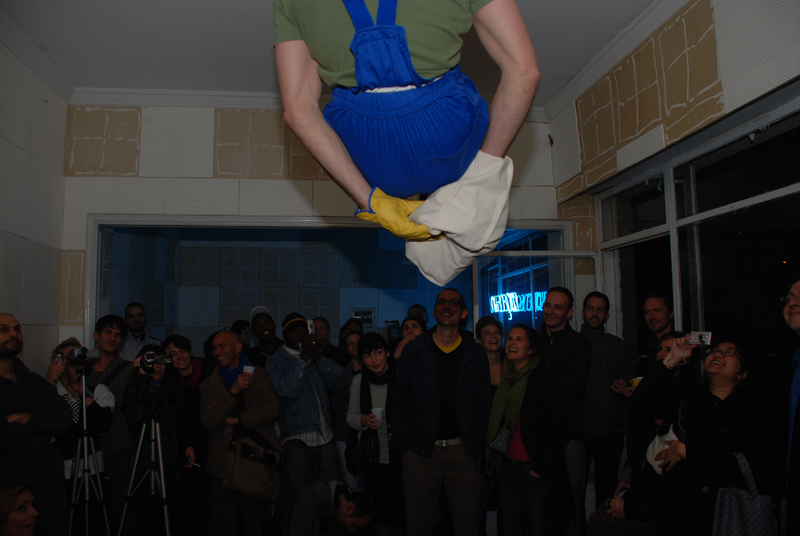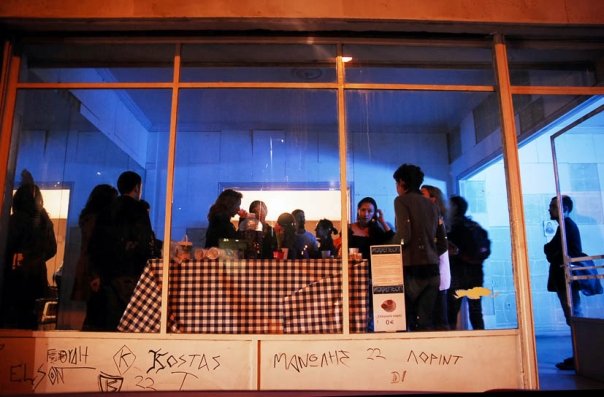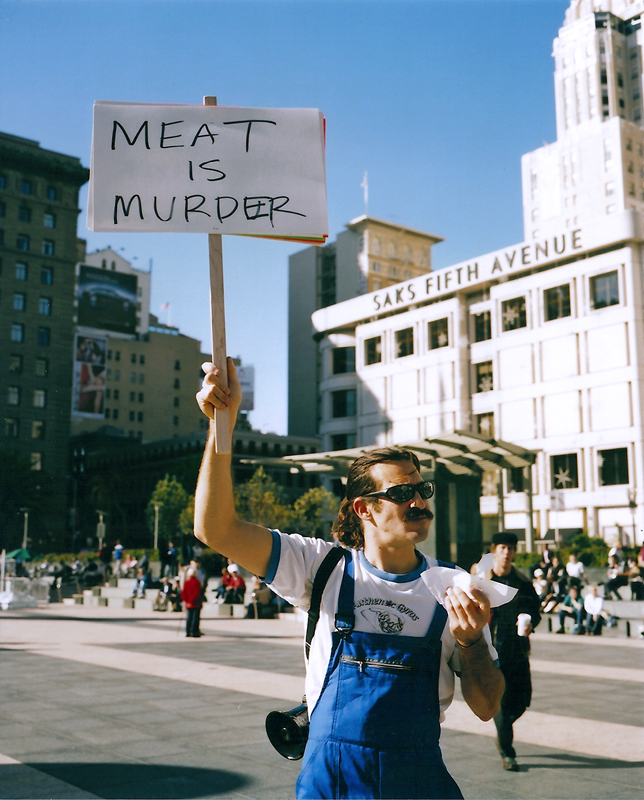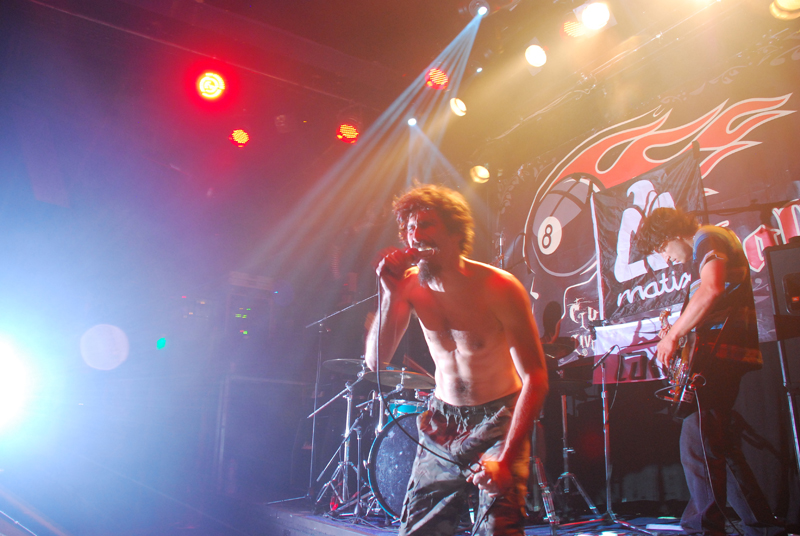Paul Zografakis is a Greek-American artist who was born and raised in St. Louis, MO and based in Athens, Greece since 2007. Paul arrived in Athens on a Fulbright Scholarship to focus on performance and then he decided to stay. He holds a BFA from Miami University, Oxford, OH (1997) and an MFA from the San Francisco Art Institute (2005).
Paul emphatically stated as we spoke, “I have been educated to seek and create opportunities and this is what I do.” His tenacity, pace, and focus are admirable, while his exceptional sense of humor and gentle nature reflect his attentive upbringing.
As you read this, he occupies a basement with his studio-mates and Betty at Gyzi, Athens. His work often borrows and appropriates from real life events, stories, magazines, and other visual audio and social experiences. He performs, he sculpts, he paints, he draws, he makes collages — he is an artist, so expect to see it all.
Greece is definitely the place to experiment with facial hair and Paul does it phenomenally well. He has even been caught sporting the old time classic Yanni look. He goes from being a Rocker to being a Cretan just like that. Please, allow me to introduce you to this promising artist and dear friend, Paul Zografakis.
Georgia Kotretsos: Since arriving in Athens three years ago, you have made an impression on me as a doer of very few means. First the project space Kafeneon and recently Athens Open Studios. You’re particularly inclusive in your efforts; are you beginning to identify your role within the Greek art community?
Paul Zografakis: When I arrived in Athens, I was already participating in projects associated with the first Athens Biennial — one called Old Timey Radio Show with ArtWaves Radio and a collaborative video with you in Karaoke Poetry Bar, organized by Intothepill.
There was a lot going on that summer in Athens, exciting times. However, as fall neared, I noticed a dire lack of artist-run initiatives and alternative art spaces; I missed the free form art approach existing in San Francisco. So, I asked my landlady to use the empty storefront in my building and that started me thinking about καφεneon (Kafeneon), which more or less consisted of coffee, lectures, and exhibitions.
At its core, Kafeneon involved opening the dilapidated store-front and serving free Greek coffee to passersby, to serve as a mechanism to entice visitors who would likely never enter an “Art Space.”
Based on conversations with friends and strangers, I arranged two lectures every Wednesday with topics ranging from BBQ and Ballet to Conflict Resolution in Africa and Professional Wrestling. It was amazing to see artists and non-artists perform each lecture with varying analog and multimedia approaches.
Organizing the exhibitions through what I like to call accidental curating, was challenging since my art contacts at the time were few. Initially I approached students at the Athens School of Fine Arts offering them the space to organize a show. I didn’t impose any rules on their participation; I was just curious to see who would jump at the opportunity. In the end, the first show consisted of 10 artists who seemed to understand the idea behind the space. The second show was a solo show by Eva Michalaki, who immediately accepted the invitation and took over the space for her large scale installation, Ik hou van je maar ik verdien je niet (I love you but i dont deserve you). The final show consisted of international videos and live performances and drew a huge crowd. I enjoyed instigating artists to take a chance, work with no budget and no time, and am humbled by the support Kafeneon received.

Paul Zografakis, "Uber Creation and Ultimate Destruction of the Universe," performed at Kafeneon's Final Show, Athens, 2008.
Most of my close friends in Athens I made through Kafeneon, including my studio mates Sifis Lykakis, Stelios Karamanolis, and Tula Ploumi, who constitute the Athens Open Studios team.

Betty, Stelios Karamanolis, Tula Ploumi, Paul Zografakis, and Sifis Lykakis at their studio in Gyzi, June 2010
The idea came from conversations about who and where are the artists in Athens, so we decided to find out. Greeks don’t tend to collaborate or participate easily but as I learned through Kafeneon, if there is a mechanism, participation is inevitable. So very much in the spirit of inclusiveness, we created AOS, which was a simple call for artists in Athens to open their studios (whether kitchen or bedroom) on the same days. Simple and non-pretentious was our intent, and we are happy with the outcome which included about 50 artists, who took a step towards strengthening an obscure Greek artistic community.
My role in this community? Well I can go to only so many gallery openings before getting bored. I am a firm supporter of creative discussion, collaboration, and risk-taking and will align myself with anyone willing to explore new modes of artistic undertakings in Athens.
GK: In your performances, specifically Frontman From Middle Earth, 2009; In Conversation With…, 2008; and Waiting for a Sign, 2006, I get the sense of a Broken Telephone idea running through these projects. The desire to communicate, to create the conditions for participation and your effort to deliver unrehearsed material, asks of your viewers to adapt to the conditions of your experiments. Please reflect on these performances and enlighten us on how you’ve set up these complex interactions.
PZ: The broken telephone is a great analogy. I would also accept photocopy of a photocopy, but most of my work does contains a sense of convolution. The idea is to take everyday tropes — an interview, a protest, or rock concert — and inject an element of discomfort — a variable, middle-man, whatever — as long as it takes the situation out of my control and forces me to improvise and solve problems. I believe people participate in my work because they identify with the scenario; it’s not as foreign to some as participating in a discussion about painting, and therefore they feel comfortable.
In Waiting for a Sign, I merely gave people a medium for expressing their feelings without consequence, since I took ownership of their messages with the help of my trusty bullhorn.
In Conversation With…, I created the situation of a closed room discussion for participants to talk freely and answer difficult if not personal questions without judgment, since the interviews were being broadcast live without sound in another area of the exhibition space.
The room became very much a confessional, while the viewers focused on physical aspects of interpersonal communication – imagining what it was we were talking about.
Frontman From Middle Earth was the most fun I’ve had making art!
A month prior to the performance, I asked friends to write songs for me, just lyrics, whatever…however they wanted. I started memorizing these lyrics and found NOVO, a 2-man band in Thessaloniki who agreed to help. So I showed up to the performance with my lyrics and they showed up with their music and we started playing. Simply, the idea was to be a Rock Star of failure. Since I had never heard NOVO play before, I was having to fit my memorized lyrics to their music in real time, while playing the part of Rock Star, on stage, in front of a live audience. Not easy! In the end though, it must have been better than I thought because a few fans hung around to thank me.
And, that’s not quite a wrap yet. The second half of my discussion with Paul will be posted this coming Monday. Stay tuned! We will be talking about his latest work, the first body of work he created in Athens, and his new creative endeavor.










Pingback: Artist News » Inside the Artist's Studio: Paul Zografakis | Art21 Blog
Pingback: Inside the Artist’s Studio: Paul Zografakis Part 2 | Art21 Blog